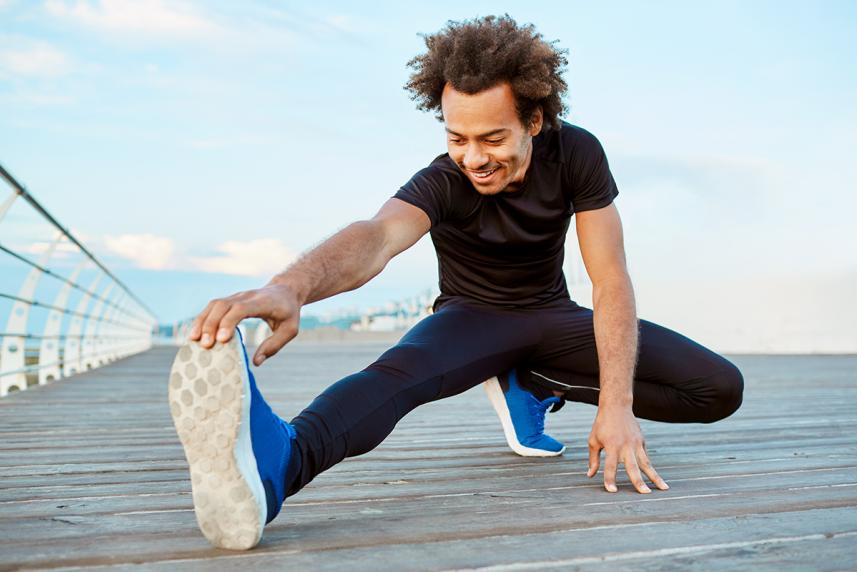
We have more than 90,000 doctors at over 2,000 locations. Our team will help you get the care you need, when and where you need it.

Running has physical and mental benefits, no matter what your age. Here’s how to get started.
Looking for a fun activity that doesn’t require a gym membership? Running is a great way to get some exercise. Plus, it has a lot of wonderful physical and mental health perks. And just like with walking, you can run almost anywhere.
One of the biggest perks of running? It can be good for your heart.1 Running gets your heart rate up and helps strengthen your heart muscle. That makes it easier for your heart to pump blood into your lungs and the rest of the body.
Running also improves how your lungs work, which can help with breathing. And it’s terrific for your bones.2 That’s because weight-bearing exercises, like running, force you to work against gravity and carry your own weight.3
But that’s only one-half of the equation. Running is also fantastic for your mind. In fact, running can:4
Before you start running, talk to your doctor. They can help you figure out if it’s safe for you. For example, maybe you’ve recently had knee surgery. If so, it’s probably not a good idea to start running right now.5 You may need to modify your running program for other reasons too. For example, if you haven’t worked out in a while, or you have a health condition like heart or lung disease.
If you’re new to running, you may be wondering where to begin. Follow these steps to start off on the right foot.

We have more than 90,000 doctors at over 2,000 locations. Our team will help you get the care you need, when and where you need it.
When you’re first starting out, the important thing is to start slow, says Billy Ryan. He’s a Chicago-based certified health coach at Real Appeal. Start with walking first. Try walking a mile and timing yourself. Then walk a little bit faster and aim to improve your time.
Ready to step it up and add some running? You can find many starter plans online, but here’s a simple one to try:6
Week 1: Three days this week, alternate between running and walking for 20-30 minutes total. For example, you might run for 2 minutes, then walk for 1 minute. Then run for 2 minutes again, then walk for 1 minute. Choose the ratio that feels comfortable for you. Do this until you reach 20-30 minutes.
On the other days, go for a walk, ride your bike, or swim. You might set aside one day to rest (meaning not do any exercise at all).
Week 2: Three days this week, alternate between running and walking for 20-30 minutes total. But run more and walk less. For example, you might run for 3 minutes, then walk for 1 minute. Then run for 3 minutes again, then walk for 1 minute. Do this until you reach 20-30 minutes.
Week 3 and beyond: Repeat Week 2, increasing your running time. You can continue to run/walk. Or you can work your way up to running the full 20-30 minutes. You can add on speed and distance from there.
As you increase your running, listen to your body. If your muscles feel too sore to run one of those days, walk or take a rest day. A bit of muscle soreness is normal.6
But if you run too hard and too much, it could lead more serious issues. One to be aware of: plantar fasciitis. That’s when the thick tissue that connects your heel bone to your toes becomes inflamed, causing sharp pain in your heel area.7 You might also get runner’s knee. That happens when you put too much pressure on your knees, and it causes pain around your kneecap.8 And shin splints are common in runners too. This is pain along the inner edge of your shinbone caused by inflammation of the tissues surrounding the shinbone.9
The good news is that you can run just about anywhere, depending on the season and where you live. In warm weather, you could run on the sidewalks around your neighborhood or on a paved path at a local park. Or you can run on an outdoor track at your local high school. In colder weather, you can run on an indoor track or a treadmill.
Be aware of the surface you’re running on. When you are outdoors, smooth, flat surfaces are easier on your body. Hills can put more stress on your feet and ankles.10 Be aware of changing surfaces, like curbs, gravel paths or muddy spots.
Get health tips you can trust delivered straight to your inbox. Sign up for our health and wellness newsletter today.
When you’re out for a run, safety is a big deal. Be aware of your surroundings. For example, if you’re running on the side of a road, you want to run against traffic, so you can see what’s coming at you. Here are some other helpful tips:11
It’s important to have the right pair of running shoes, says Ryan. They’ll need to be:
If this is your first time buying running shoes, you may want to shop in person at a running shop or sporting goods store. The people who work there can help match the shoe to the shape of your foot and how you actually run.
Running isn’t only about the shoes. When you run, you’ll want to wear comfortable, lightweight clothes, such as running shorts and a T-shirt. And you can wear layers, depending on the season.
That same store where you bought your running shoes will likely have a great selection of running clothes. All you need to do is ask the person who helped you with the shoes about them.
Some people just get up and go every day. Others may need motivation. Here are some ways to keep yourself on track:
Track your progress. Both Ryan and Metzler suggest tracking your runs with your smartphone, smartwatch or fitness tracker. You can even use a special running app. Or you can do it in a running journal on paper or a tablet.
Listen to music. Music may help your mood or motivation while you work out.11 It can also make your run go by faster. You can make your own “running playlist” or listen to music on a streaming service.
You can also check out your favorite podcast. (Check out Optum’s podcast, Until It’s Fixed.)
Find a friend. Running with a friend isn’t just safe. It’s also good for motivation. And it’s even better if you have the same running goals.
If you enjoy running, you may want to join a running club. Other people can give you motivation and support. Ask your neighborhood sports store or gym about local running clubs.
Sound fun? You probably didn’t know it, but you had running in you all along.
You can buy a fitness tracker and other workout gear in the Optum Store. Start exploring.
Sources
© 2024 Optum, Inc. All rights reserved. Do not reproduce, transmit or modify any information or content on this website in any form or by any means without the express written permission of Optum.
The information featured in this site is general in nature. The site provides health information designed to complement your personal health management. It does not provide medical advice or health services and is not meant to replace professional advice or imply coverage of specific clinical services or products. The inclusion of links to other web sites does not imply any endorsement of the material on such websites.
Consult your doctor prior to beginning an exercise program or making changes to your lifestyle or health care routine.
Stock photo. Posed by model.